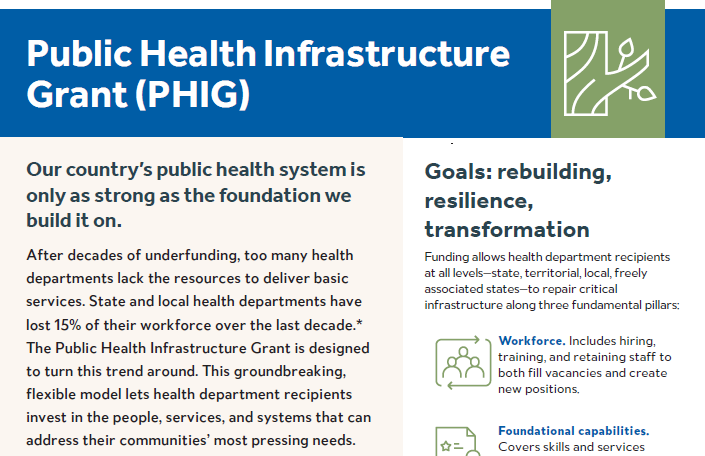Key points
- CDC's Public Health Infrastructure Grant (PHIG) is a groundbreaking investment supporting critical public health infrastructure needs across the United States.
- One hundred and seven health departments and three national public health partners received funding through this 5-year grant (12/1/2022 - 11/30/2027)
- PHIG gives health departments the flexibility to direct funds towards specific organizational and community needs that strengthen public health outcomes.

Overview
As of December 2024, CDC awarded $4.8 billion through the Public Health Infrastructure Grant (OE22-2203: Strengthening U.S. Public Health Infrastructure, Workforce, and Data Systems) to help U.S. health departments promote and protect health in their communities.
The total award includes nearly $4.5 billion for health departments and $361 million for three national public health partners.
Impact
CDC expects to award more than $5 billion over the 5-year grant period. This includes nearly $4.5 billion for health departments and $361 million for three national public health partners.
The purpose is to create a stronger, more resilient public health system that is ready to face future health threats. For examples of recipients' service to communities, visit the PHIG Partners Stories web page and ASTHO's podcast series.
Funding recipients
Funding was awarded to:
- One hundred seven (107) public health departments in all 50 states, Washington D.C., 8 territories/freely associated states, and 48 large localities (cities serving a population of 400,000 or more and counties serving a population of 2,000,000 or more based on the 2020 U.S. Census). Award amounts were based on a funding formula that included population size and community resilience. As of December 2024, nearly $4.5 billion for health departments ($3.685 billion in fiscal year (FY)23, $511 million in FY24, and $245 million in FY25) has been awarded. Recipient-specific information is provided on the Health Department Profiles.
- Three national partners that support the work of the 107 funded health departments. The Association of State and Territorial Health Officials (ASTHO), National Network of Public Health Institutes (NNPHI), and Public Health Accreditation Board (PHAB) received over $361 million ($155 million in FY23, $185 million in FY24, and $21 million in FY25). These organizations provide training and technical assistance, evaluate the program, and facilitate coordination and communication across recipients and CDC. Learn more.
Strategies and outcomes
The three strategies of this grant are Workforce, Foundational Capabilities, and Data Modernization. Recipients are expected to achieve several key outcomes by the end of the 5-year performance period (see image below). Ultimately, this grant will lead to accelerated prevention, preparedness, and response to emerging health threats. Improved outcomes in other public health areas are also anticipated.
All work done as part of this grant is grounded in three key principles:
- Data and evidence drive planning and implementation.
- Partnerships play a critical role in grant program success.
- Resources are directed to support diversity and health equity.


